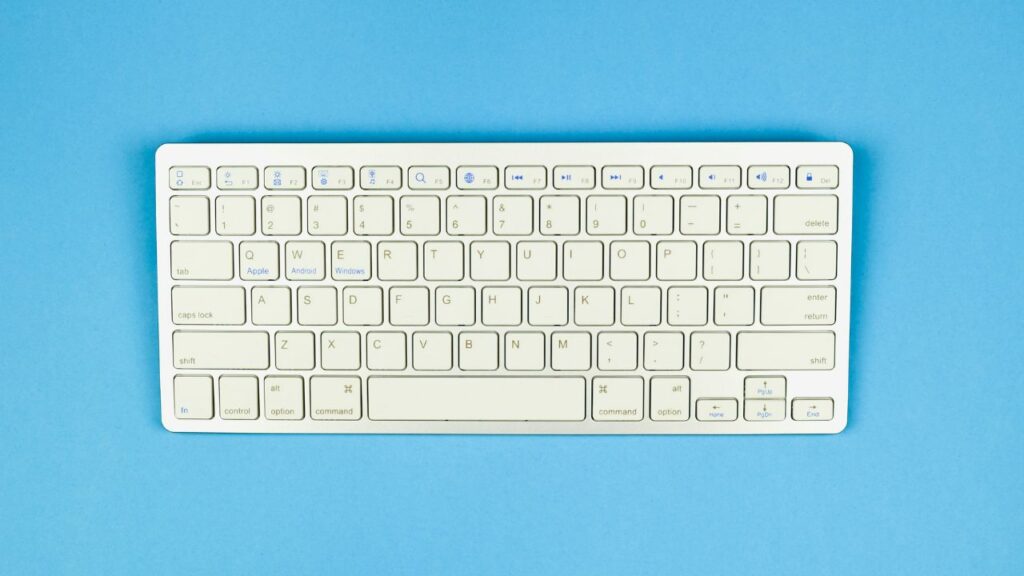
In the vast world of keyboards, size indeed does matter. There’s a broad spectrum to choose from, starting from the robust, full-sized keyboards all the way to the compact yet powerful 40% variants. Each comes with its unique strengths, tailored to fulfill varying needs. This guide aims to lead you through the diverse landscape of keyboards, helping you uncover the ideal size for your typing and gaming adventures.
The Full-Sized Keyboard (100%): The Complete Package
Regarded as the flagship of keyboard sizes, the full-sized keyboard, commonly known as the 100%, leaves no stone unturned. Equipped with every key you might ever need – alphanumeric keys, number pad, function keys, and even multimedia keys – it serves as the quintessential keyboard in many respects. Its dedicated number pad makes it a popular choice for frequent number users, while its generous layout facilitates extended typing sessions. However, be mindful of its large footprint that requires considerable desk space and its potentially higher price point due to the all-inclusive feature set.
The 1800 Compact (96%) Keyboard: Space-Efficient Yet Comprehensive
A step down in size, we encounter the 1800 Compact, a cleverly designed 96% variant of the full-sized keyboard. This ingenious layout compresses the number pad and the other keys into a more manageable frame, offering a narrower width. This space-efficient design is an asset for those working in tight quarters. However, bear in mind that the closely packed keys may necessitate a slight adjustment period.
The Tenkeyless (TKL) Keyboard (87%): The Happy Medium
The Tenkeyless, often abbreviated to TKL, delivers a harmonious blend of size and functionality. By shedding the number pad, this 87% keyboard offers a more desk-friendly footprint, making it a crowd favorite. Despite the size reduction, it retains critical keys like the arrow keys, home cluster, and function keys. It’s the preferred choice for users seeking a more compact form factor without significant feature compromise.
75% Keyboards: The Rare Find
The 75% keyboard is a bit of a rarity but highly appreciated by its users. This keyboard size includes all keys in a compressed layout, with the home cluster and arrow keys either smushed together or separated based on the specific layout. Its compact size and unique design make it a hit among gamers. Despite its advantages, finding one can be a bit of a treasure hunt due to its rarity.
65% Keyboard: The Popular Choice
The 65% keyboard is the popular kid on the block. It’s easy to find and comes in a compact size that is ideal for those looking to save desk space. It ditches the number pad, function row, and home cluster on some layouts, but it retains the dedicated arrow keys. It’s a great choice for those who want a compact keyboard without losing the convenience of dedicated arrow keys.
60% Keyboard: Compactness Redefined
At the further end of the compact scale, we find the 60% keyboard, which takes minimalism to new heights. It’s a budget-friendly option due to its reduced size, and it also caters to DIY enthusiasts who relish the idea of building their keyboard. However, its extreme compactness may not be everyone’s preference, as the smaller size might make typing a tad challenging for those with larger hands.
40% Keyboard: The Smallest Keyboard
Venturing into the smallest end of the keyboard spectrum, we find the 40% keyboard. As small as keyboards get while still being usable for typing, these keyboards require a bit of a learning curve as they often require switching layers to input numbers and symbols.
Detached Number Pads
For those who desire a more compact keyboard without losing the convenience of a number pad, the solution is surprisingly simple: a separate number pad. This versatile addition can be placed on either side of your keyboard, optimizing desk space. Moreover, it minimizes the risk of unintended key presses during gaming sessions, as you can position it at a comfortable distance from your main keyboard.
Macro Pad
A macro pad is a custom-built piece of hardware that offers a whole new level of keyboard customization. Sourced online through group buys, a macro pad allows you to program all the keys with macros or shortcuts for repetitive tasks. This can be a game-changer for workflow efficiency, although it does require a bit of technical know-how to set up and use effectively.
Considerations When Choosing a Keyboard Size

Selecting the right keyboard is a blend of personal preference and practical needs. When it comes to choosing between small versus large keyboards, keep in mind the following aspects:
Usage: Are you a hardcore gamer, an occasional typer, or someone who crunches numbers all day? Different keyboard sizes cater to different usage scenarios.
Desk Space: A full-sized keyboard requires more real estate than a 60% or 40% keyboard. If you’re working with limited space, a smaller keyboard might be the ticket.
Hand Size: Larger hands might find a 40% keyboard too cramped, while those with smaller hands might find a full-sized keyboard a stretch too far.
Portability: If you’re always on the move, a compact keyboard will fit more comfortably into your bag than a full-sized one.
Small vs Large Keyboards: A Comparison Table
To help you decide, here’s a handy comparison table showing the key features, advantages, and disadvantages of different keyboard sizes.
| Keyboard Size | Key Features | Advantages | Disadvantages |
|---|---|---|---|
| Full-Sized (100%) | All keys including a number pad, function keys, and multimedia keys | Ideal for heavy number entry, comfortable for extended typing | Bulky, takes up more space, might be more expensive |
| 1800 Compact (96%) | Slightly narrower than full-sized, compresses the number pad and other keys | Space-saving, good for confined spaces | Keys are more closely packed, which might require some adjustment |
| Tenkeyless (TKL, 87%) | No number pad, but includes arrow keys, home cluster, and function keys | Balance between size and functionality, more compact than full-sized keyboards | Lacks a number pad, which might be inconvenient for some users |
| 75% Keyboard | All keys in a compressed layout, layout varies | Compact size, good for gaming | Uncommon, can be harder to find |
| 65% Keyboard | No number pad, function row or home cluster on some layouts, includes dedicated arrow keys | Compact, easy to find, saves desk space | May lack certain keys depending on layout |
| 60% Keyboard | Smaller size, fewer keys | More affordable, can be built DIY | Too small for some users |
| 40% Keyboard | Smallest keyboard, fewer keys | Extremely compact and portable | Requires frequently changing layers to enter numbers/symbols, may impact typing experience |
Keyboard Sizes and Ergonomics
Ergonomics is an often overlooked, yet essential aspect of choosing a keyboard. A well-designed keyboard can reduce the risk of repetitive strain injuries (RSIs) and contribute to more comfortable typing or gaming sessions.
Full-sized and compact 1800 keyboards, with their larger size and standard layout, often provide good support for the hands and fingers, reducing strain during extended use. Tenkeyless and smaller keyboards, on the other hand, allow for a more natural hand and arm position as they let you place your mouse closer, reducing the need for reaching out. But keep in mind, smaller keyboards can be less comfortable for some due to the cramped layout.
An ergonomic assessment should also take into account the keyboard’s height and whether a wrist rest is used. Using a keyboard that’s too high or without proper wrist support can lead to discomfort over time.
Key Layouts
Keyboards come with varying layouts, each offering a unique typing experience. The universally prevalent QWERTY layout, named after its first six letters, originates from the typewriter era and is the default option globally.
However, compact keyboards often come with non-standard layouts. For instance, many 40% keyboards optimize space by eliminating certain keys and introducing layering functionality.
Two other noteworthy layouts are Dvorak and Colemak. Dvorak strategically places frequently used keys under your strongest fingers, theoretically boosting typing speed. On the other hand, Colemak subtly modifies the QWERTY layout, moving a few keys to facilitate a more efficient typing experience.
Before you settle on a keyboard, take some time to ponder over the layout that would best match your typing patterns and requirements. Remember, your keyboard layout significantly influences your typing speed, precision, and comfort.
Conclusion
The realm of keyboards is an expansive one, brimming with options of diverse sizes and layouts to meet the needs of any user. Perhaps you need a full-sized keyboard for heavy numerical work, or maybe a 65% compact one for general usage, or even a 40% keyboard for ultimate portability, rest assured there’s an ideal keyboard waiting for you. For a more in-depth understanding of keyboard sizes, explore this comprehensive guide on keyboard sizes.
For those venturing into the compact end of the keyboard spectrum, the 40% keyboard presents a unique typing experience focusing on space optimization and portability. You can peruse this selection of the best 40% keyboards to help you make a well-informed choice.
Ultimately, the perfect keyboard for you hinges not just on size, but also on comfort, functionality, and how well it meshes with your personal or professional life. So, gear up for an exhilarating typing journey!